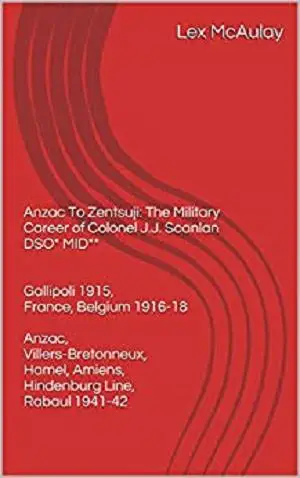Anzac To Zentsuji: The Military Career of Colonel J.J. Scanlan DSO* MID** Gallipoli 1915, France, Belgium 1916-18 Anzac, Villers-Bretonneux, Hamel, Amiens, Hindenburg Line, Rabaul 1941-42 by Lex McAulay
English | July 29, 2012 | ASIN: B008QTJ02Q | 359 pages | AZW3 | 0.98 MB
English | July 29, 2012 | ASIN: B008QTJ02Q | 359 pages | AZW3 | 0.98 MB
Colonel Jack Scanlan was an original Anzac, landing with the 7th Battalion AIF, was later wounded and returned to Australia, but when fit again went to France and spent the rest of the war in action there. He was trained at brigade and division level and took part in the battles of the 15th Australian Infantry Brigade, commanded by Brigadier H. 'Pompey' Elliott in 1917 and 1918. Promoted to command the 59th Battalion AIF he led it through the famous battles of 1918, especially at Villers-Bretonneux, on 4 July 1918 and at Amiens and Peronne.
He was awarded the DSO and Bar and three times was Mentioned in Dispatches, as well as being recommended for other decorations.
Recalled to service in 1939, in October 1941 he was sent to command Australian forces at Rabaul. Here he found that the assigned task was beyond the capabilities of the small force placed there and that no evacuation would be possible if the Japanese attacked. This they did in overwhelming force and Scanlan was required to surrender to save the lives of his men, who were being killed by the Japanese as they captured them.
Scanlan survived the war in captivity in Japan, for some of the time at Zentsuji Camp. He returned to Australia so disgusted by the abandonment of the Rabaul garrison that he refused to contribute to the official Australian history of the war.
This book describes the war service of Jack Scanlan and that of some of the men who served with him in the 7th and 59th Battalions, the conditions in which they served, the battles in which they fought, and the trench raids they made on the Germans.
Some of the myths about the Aussie digger are exposed as creations of the media, not the soldiers - that training was not really necessary, that food was bullybeef and biscuits, and that everyone was equally brave all the time.
The basis of the book is derived from official war diaries and interviews of participants of actions soon after the event, with some post-war accounts of the men and units involved.
No WW1 veterans remain but their contributions to the interview program of 15th Australian Infantry Brigade allow them to live on.



